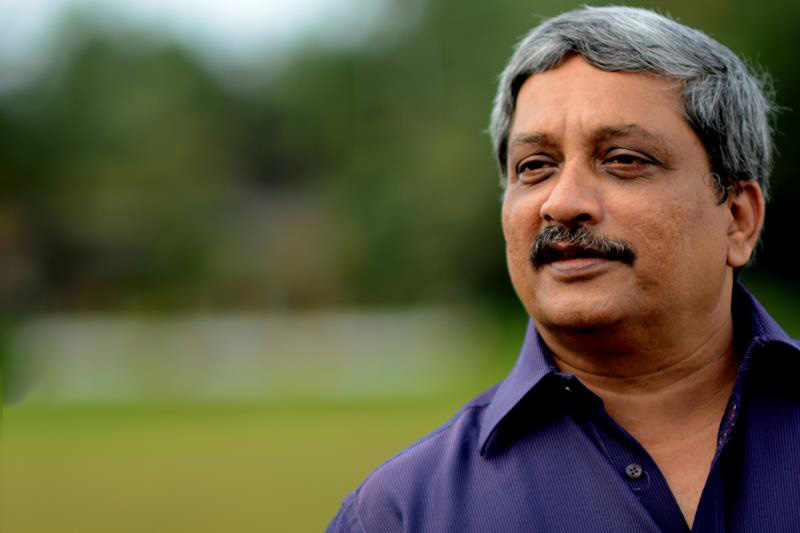Chief Minister Manohar Parrikar-led coalition government was sworn in on March 14, after the 61-year old politician, formed an alliance within just 24 hours after the State Assembly results were declared on March 11. It was not a clear mandate for BJP, who despite that managed to retain their power in the state for the second successive term.
On June 21, the Parrikar government completed 100 days in power. Although, 100 days is too short a period for making an honest assessment of the performance of any organisation, particularly that of a government, but administrative steps, policy initiatives or law making does offer some insight into the ways and thinking of a government.
There is very little to cheer in the first 100 days of the new government, which went on with Parrikar busy pleasing his coalition partners- Maharashtrawadi Gomantak Party (MGP), Goa Forward Party (GFP) and the Independents. Ironically, while appeasing his “new friends”, the ‘bhai’ upset his own leaders, when he decided to revert back the decisions taken by the previous Laxmikant Parsekar-led government.
As we all know, the government formation was embroiled in major controversy when Congress who emerged as the single largest party with 17 MLAs and support of two Independents failed to stake its claim to form the government.
Often known as the ‘master’ of politics, Parrikar proved the political analysts true, when he displayed splendid political acumen and skill in forging a coalition with its former allies and the recent ‘opponent’ MGP and the hard core anti-BJP force GFP led by MLA and present Minister Vijai Sardesai.
BJP and its allies move was termed as “greed for power” by political analysts. Whatever said and done, the biggest challenge before this coalition government is to give ‘stable governance’ to the people of Goa for next five years.
It did not end here. After managing to saffronise two former Congressmen Mauvin Godinho and Pandurang Madkaikar before polls, it was now time for Congress elected Valpoi MLA Vishwajit Rane to switch sides for power.
On the D-Day of the crucial Floor test on March 16, Rane ditched his party by not voting on the Floor of the House that gave clear mandate to Parrikar.
Rane later resigned the party to join BJP. He was sworn in as Health Minister in April and now is set to re-contest the by-polls.
As we take a look at the first hundred days of the new government, what we could see is that it was not a very good start for the Parrikar regime. He took over power at a crucial stage when over 2500 liquor outlet operators including bar and restaurant owners, located within 500 meters of national and state highways, were on the verge of shutdown following the Supreme Court order.
Owing to the election code of conduct and considering the fact that the SC order has no direct implications on it, the government showed reluctance in challenging the order. A move that was strongly criticised by the opponents. But, the government got solace when the Supreme Court modified its order in the last week of March stating that liquor outlets beyond 200 meters in the municipal areas got relief while for others the axe continued till date.
Within ten days of coming to power, Parrikar presented revenue oriented and not so populist State Budget 2017-18- projecting a 11 percent growth and sought to ramp up spending on infrastructure but spared common man from any additional levies except for hike in petrol prices, which he said was the need of the hour with inflationary prices and to generate revenue for the state exchequer.
With shrinking state economy and the revenue backbones, iron ore mining and tourism, failing to give expected income, the government is now completely banking on its Centre share and allocation to keep the pace going. The revamp of state financial situation, while keeping the balance between spending on social welfare sector and development, is one of the biggest challenges that Parrikar faces today, and it did reflected in the state budget.
Parrikar government earmarked Rs 978 crore to social sector and Rs 2482 crore for infrastructural sector that includes whopping 40 percent rise in budget for public works.
A close analysis of the Budget indicates that Parrikar has laid emphasis on his unfulfilled budgetary promises made by him during his earlier tenure in 2012-14 (during which he presented three Budgets), be it time bound service to citizens, or completion of Mandovi and Zuari bridge, or commencement of South Goa district hospital or self-sustain agriculture sector or garbage free Goa or rehabilitation of slum areas. The promises remained mere announcements on Budget documents.
Beggar free Goa, traffic management, voluntary retirement (VRS) to ‘lethargic’ government employees, revamp of education sector, ex-servicemen to man the mismanaged Goa medical college administration, proper mechanism to maintain the created infrastructure, are some of the new initiatives promised by the government.
The current government has five new and young faces as first time Ministers, of which, it is a maiden tenure for three legislators. Vijai Sardessai, Rohan Khaunte, Jayesh Salgaoncar, Vinod Palyekar and Govind Gawade, are the new faces in the Parrikar chaired cabinet.
Young and enthusiastic Ministers were seen quite active during this period, when TCP Minister Vijai Sardesai, Revenue Minister Rohan Khaunte and Water Resources Minister Vinod Palyekar made surprise visits to their respective departments initiating stern action against the ‘late comers.’ Several government employees were placed under suspension for their lethargic attitude towards work.
When his cabinet colleagues were in action, Parrikar too surprised employees through his sudden visits. Rane too made several surprise visits to the Goa Medical College and Hospital (GMC), where he was shocked to see the condition and took the concerned authorities on radar.
Such moves were expected from the Ministers to prove their worth after taking over on the chair for the first time.
The only Ministers who were seen more active in their duties were Vishwajit Rane, Rohan Khaunte, Vijai Sardesai and Vinod Palyekar.
Within two months of taking charge as Health Minister, Rane took several decisions to normalise the GMC, which was in ‘coma’ for last five years. Appointing new medical superintendent, dean and special consultant was taken on priority. Adding new ambulances to the existing fleet of 108 with GPS service, re-designating existing consultants in super-speciality departments, subsidised medicines etc., were some of the quick initiatives of the Minister.
Khaunte too showed keen interest in his departments of Revenue and Information Technology. He launched e-portal taking all revenue services online and to the door-step of the public. He even took step to evict the Mahiti Ghars following complaints from public.
On the IT front too, he was successful in preparing a draft start-up policy for the state.
Minister for Town and Country Planning and Agriculture Vijai Sardesai and WRD and Fisheries Minister Vinod Palyekar, also made several efforts to understand their new departments. Palyekar showed keen interest in the state’s contentious Mhadei water diversion issue, which is currently fought before Tribunal between Goa, Maharashtra and Karnataka.
While the new Ministers from GFP and few Independents were seen in action, the Ministers from BJP (except Vishwajit Rane) and MGP were seen inactive. Be it BJP’s Power Minister Pandurang Madkaikar or Panchayat Minister Mauvin Godinho or MGP’s PWD and Transport Minister Ramakrishna Dhavalikar or Tourism and Sports Minister Manohar Azgaonkar- no major initiatives or announcement came from their concerned departments.
A close analysis of the government, ever since it took over, reveals the very fact that Manohar Parrikar left no stone unturned to keep his coalition partners “happy”. Be it allocating the major portfolios or corporations like Goa State Infrastructure Development (MGP)and South Goa Planning and Development Authority (SGPDA) (GFP) or re-looking at his own previous government’s decisions like amendment to the Agriculture Tenancy Act, re-classification of coconut as tree and review of projects approved by Investment Promotion Board (IPB)-Parrikar went all out to ‘satisfy’ his alliance partners, while upsetting his party colleagues like Laxmikant Parsekar, Rajendra Arlekar amongst others.
The common minimum programme, released with a theme ‘sabka sath sabka vikas with Goenmkarpon’, reflected the aspirations of the coalition partners. However, unfortunately, the document failed to assure people as by when the off-shore casino vessels would be shifted out of River Mandovi, a promise that BJP government gave during its earlier tenure in 2012-17. On the contrary, it speaks about drafting a policy for removal of floating casinos- a tactic to ensure that off shore vessels continue to be anchored in Mandovi.
As the government completes 100 days, the latest three-month extension granted to the off shore casino vessels to shift also ends on June 30. Government, who assured to identify an alternative site for their relocation, failing which the three-month extension would be automatically turned into six months, made no single move in that direction. So, at least for another three months, the casinos are here to stay.
Though the first three months were not marred in any controversies surrounding the government, the Union government’s notification imposing restrictions on sale of cow for slaughtering and subsequent demand for beef ban from right wing Hindu outfits, created much unrest amongst public especially the minority community. While the government made its stand clear, stating ‘it will follow the law’, a fear about possible beef ban looms large on the state where beef is a part of the cuisine for a large section of society in the coastal state.
As we said in the beginning, 100 days are too short a period to judge performance of any government. Hence, the public will have to wait for the Parrikar-led coalition government to complete one year to rate the governance.
Team TNV



























